How To Turn Off Update Check And User Data Sending Ableton
5. Managing Files and Sets
Various types of files are used in making music with Alive, from those containing MIDI (see v.3) and audio (meet v.two), to more programme-specific files such as Live Clips (come across 5.4) and Live Sets (come across five.five). This chapter will explain everything y'all need to know virtually working with each of these file types in Live. However, we should outset take a look at Alive's browser, through which most files arrive in the programme.
v.one Working with the Browser
Live'due south browser is the identify where you interact with your library of musical assets: the core library of sounds that are installed with the programme, any additional sounds you've installed via Ableton Packs, presets and samples yous've saved, your Ableton and third-party devices, and any folder on your hard drive that contains samples, tracks, etc.

The browser display is divided into left and right sections, called the sidebar and the content pane respectively. To resize the sections, drag the divider line horizontally.
five.1.one Understanding the Browser's Hierarchy
Working in the browser involves choosing one of the labels from the Collections, Categories or Places sections in the sidebar, and so selecting from the items that appear in the content pane.
The Collections labels each have their own assignable color, which you lot can use to tag items (including folders) that appear in the browser's content pane. These labels (or "tags") enable you to quickly organize and access particular browser items (for instance, your favorite or most-used items).
You tin assign Collections labels via a selected item'south correct-click(Win) / CTRL-click(Mac) context carte, or by using the number key shortcuts 1 through to 7. Apply 0 to reset color assignments.
Note that Collections labels tin can also be assigned to multiple browser items within a selection. Additionally, it is possible to assign a colour characterization to different item "types". For example, y'all can assign the aforementioned color characterization to a drum audio, a MIDI effect, and a plug-in.
Clicking on a Collections label in the sidebar shows all items tagged with that color. Folders that appear in the Collections labels tin can be unfolded to prove their contents.
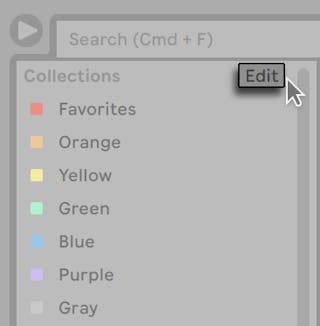
Each label tin exist renamed via their right-click(Win) / CTRL-click(Mac) context menu, or by pressing CTRL-R(Win) / CMD-R(Mac). You can choose which labels are visible in the browser, by clicking the Edit push next to the Collections header, and checking the Bear witness/Hide Label pick next to each label.
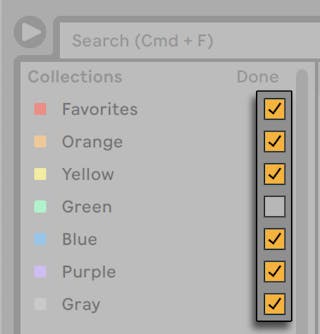
To exit Edit Manner, printing the "Washed" button.

Notation that when a hidden unassigned colour becomes assigned to a browser particular, the Collections label for that color will be shown in the sidebar automatically. However, visible color labels are not automatically hidden if all their assignments are removed.

In the content pane, square icons indicate the respective color(s) assigned to each item. Annotation that although multiple colors can be assigned to an item, no more than than iii of those colors will be shown in the content pane.
The Categories labels prove all items of a given blazon, regardless of where they are in your library. Use this section to explore and observe all of the instruments and sounds you take installed. The Categories section is organized as follows:
- Sounds — all of your Instrument Racks (meet Chapter 20) and musical instrument presets, organized by the type of sound they brand (rather than by their devices.)
- Drums — all of your pulsate presets. This includes total drum kits, which are available equally Drum Racks, as well every bit single pulsate hits, which are delivered as Instrument Racks.
- Instruments — all of your Musical instrument Racks, besides as "raw" Live instruments and their presets, organized past device (rather than past the type of audio.)
- Sound Effects — all of your Audio Consequence Racks, as well as "raw" Live audio furnishings devices and presets.
- MIDI Effects — all of your MIDI Effect Racks, as well every bit "raw" Alive MIDI effects devices and presets.
- Max for Live — all of your Max for Alive (meet Affiliate 27) devices and presets, as well equally any Racks that are built with those devices, organized into Audio Effect, Instrument and MIDI Effect folders.
- Plug-Ins — your third-party VST and/or Audio Units plug-ins (encounter 19.2).
- Clips — all of your Live Clips.
- Samples — all of your raw sound samples.
- Grooves — all of your Grooves (run across Chapter 13).
- Templates — all of your template Alive Sets (see 5.5.4).
- All results — this section appears after yous've typed something into the search field. Information technology shows search results for every section of the browser in a single list.
The Places labels show the contents of folders on your hard drives. Apply this department when you desire to access a particular identify, such as a folder you've added or an addition Pack. The actual contents of the Places section volition vary depending on how you've configured your library, but will contain at to the lowest degree the post-obit:
- Packs — all Packs that come pre-installed with Alive, too as any that you've installed yourself. Each Pack appears equally a folder in the content pane, which can exist unfolded to reveal that Pack'due south contents. Presets, samples, and Alive Clips installed by Packs will also appear in the appropriate Categories labels. The Packs label also shows updates for installed Packs, as well as boosted Packs that you can install. Please refer to Downloading and Installing Packs in the Browser (meet 5.1.2) for more information.
- User Library — the User Library is the default location for items yous save yourself, including default presets, grooves, your personalized Racks and device presets, your own samples, Alive Clips, etc. Files that you save to your User Library will also be available in the appropriate Categories labels.
- Electric current Projection — all of the files that are contained in the currently active Project (come across v.6). If you're working on a Alive Set that you lot oasis't yet saved, the current Project refers to a temporary location.
- whatever folders from any of your difficult drives that yous've added to Live's Browser.
Moving through the files in Live's browser can exist done with either the mouse or the estimator keyboard:
- Whorl upwards and down in the Browser with the up and down arrow keys, the mousewheel, or by clicking and dragging while belongings the CTRL-ALT(Win) / CMD-ALT(Mac) modifier.
- Close and open folders, or move between the sidebar and content pane with the left and correct pointer keys.
Past default, whatever previously open folders will shut when you open a new one, just you tin override this behavior by holding CTRL(Win) / CMD(Mac) while opening new folders.
5.i.2 Downloading and Installing Packs in the Browser
The Packs label in the browser shows you all Packs that come pre-installed with Alive, as well as any that you've installed yourself.
To check for existing updates for your installed Packs, navigate to the Packs label and aggrandize the Updates section.
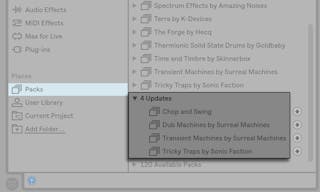
Yous can also view Packs that you own, but take non installed. These uninstalled Packs appear in the Bachelor Packs section within the Packs label.
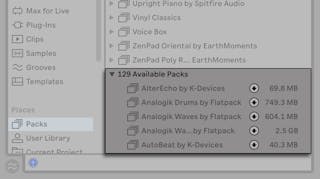
You can download any of these Updates or Available Packs by pressing the download icon next to information technology.
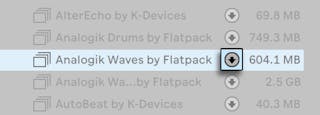
While the Pack is downloading, the download icon changes to a intermission icon that indicates the progress of the Pack'south download.
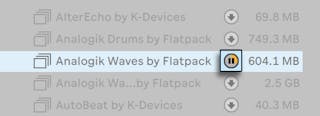
Should you demand to, yous can intermission downloads and resume them at a later point. To intermission a download, press the intermission icon. When a download is paused, the paused icon changes back to a download icon.
To resume a paused download, press the download icon over again.
(Note: you can download multiple selected Packs at the aforementioned time. Yous tin can also pause and resume downloading multiple selected Packs.)
When the download is consummate, y'all tin install the Pack by pressing the Install button.

Upon pressing the Install push, Alive volition display a progress bar that indicates the condition of the procedure.
Note that you can download a Pack, pause, resume or cancel a download, or install a Pack past choosing the appropriate command in that Pack's right-click(Win) / CTRL-click(Mac) context bill of fare.
Sometimes you might need to know the size of a Pack before you download and install information technology. For example, you may have limited space on your difficult drive. Yous can configure the browser to testify the size of all Packs that appear in the Updates and Bachelor Packs sections. To do this, right-click(Win) / CTRL-click(Mac) on the Name header in the browser's content pane and choose the Size option in the context card.
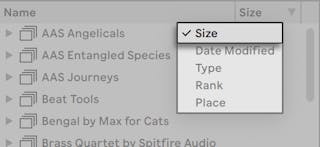
Yous can delete an installed Pack via its right-click(Win) / CTRL-click(Mac) context carte. Note that deleted Packs will announced in your list of Available Packs.
It is possible to configure Live's Preferences to prove or hide Updates and Bachelor Packs in the browser. To exercise this, press the Show Downloadable Packs toggle in the Library Preferences.

v.ane.three User Folders
Alive'due south browser allows y'all to work with your creative tools regardless of where they are installed on your figurer. This allows yous to, for instance, store large sample collections on one or more than external drives, and still utilize the browser to access their contents - there is no need to go on them in a unmarried centralized location.
In order to work with your own folders in Live, y'all must first add them to the browser, either past dropping them directly into Live from the Explorer (Windows)/Finder (Mac) or past pressing the Add Folder button in the browser'due south sidebar.
After calculation a user folder, Live will scan it, which "teaches" the browser about its contents. Following this, it volition announced in the Places department of the sidebar.
Note: adding a user binder does not really motility the folder to a new location, but simply makes it available in Live's browser. If you reorganize your drives using Explorer (Windows)/Finder (Mac), Live may not be able to detect user folders if they've been moved. For example, if a user binder is contained on an external hard drive, and Live is opened without the drive attached, the user folder will nonetheless appear in the browser but volition be grayed out. You can attempt to notice it by using the right-click(Win) / CTRL-click(Mac) context carte du jour's Locate Folder command, or tell Alive to "forget" this folder via the Remove from Sidebar control. Yous can also employ this command to remove folders that aren't missing, but which you but don't want to work with anymore.
5.i.4 Searching for Files
Alive's browser is equipped with a search field that filters the contents of the selected sidebar label as you type. To search across all locations, press CTRL-F(Win) / CMD-F(Mac).
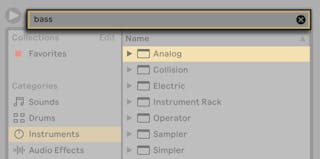
The results volition include files that match all search terms, equally opposed to any. For instance, if you search for "acoustic bass," the search will yield all acoustic bass sounds — not all acoustic sounds and all bass sounds.
For mouse-free searching, nosotros suggest the following sequence of shortcuts:
- CTRL-F(Win) / CMD-F(Mac) to identify a cursor in the search field;
- Blazon your search terms;
- Down arrow key to jump to the search results;
- Upwards and down arrow keys to scroll the search results;
- ESC to articulate the search field, showing all of the contents of the selected sidebar characterization.
Live allows yous to preview samples, clips, and instrument presets in the browser before they are imported into the program. To enable previewing, activate the Preview switch next to the Preview Tab at the bottom of the browser.

Hint: You can preview files fifty-fifty when the Preview switch is not activated by pressing Shift-Enter or the right arrow central.
Click on a file (or apply the up and down pointer keys) to select it. Click in the Tab's scrub area to make playback leap to that signal. (Annotation that it is non possible to scrub clips that accept been saved with Warp turned off.)
You can select Live Clips in the browser to load them into the Preview Tab.
You can as well preview Live's instrument presets in the Preview Tab. When selected, you'll hear a short audio instance of the preset, so yous can get an idea of how it sounds before loading it.
With the Raw push enabled, files will preview at their original tempo and will not loop. With Raw disabled, Live will endeavour to preview files in sync with the current Set, and then that you can better judge which samples will work for you. Please note that scrubbing is non possible when Raw is enabled.
The previewing volume can be adjusted using the mixer'due south Preview Book knob.

If your sound hardware offers multiple audio outs, you tin can privately audition, or cue, files via headphones continued to a separate pair of outs — while the music continues to play. To learn how to ready up Live for cueing, please refer to the relevant section (see 16.half-dozen) of the Mixing chapter.
At that place are several ways to add together clips to a Live Set:
- Files can exist dragged and dropped from the browser into tracks in the Session or Arrangement View. Dragging and dropping fabric from the browser into the infinite to the right of Session View tracks or beneath Arrangement View tracks will create a new track and place the new clip(s) there.

- In the Session View, double-clicking or pressing Enter on a file in the browser will automatically create a new rail to the right of the other tracks and load it with the prune.
- Files can be dropped directly into Live from the Explorer (Windows)/Finder (Mac).
In addition to the elevate-and-drop method of loading files from the browser, Live offers a Hot-Bandy Mode to reduce your mouse travel. Hot-Swap Mode can be toggled on and off with the Q primal, and establishes a temporary link between the browser and, for example, a virtual instrument. While in Hot-Swap Mode, you can footstep through samples or presets to audition them "in place," that is, within the instrument. Hot-swapping for presets is covered in the Alive Device Presets section (encounter 19.1.i). Let's go through an example of hot-swapping samples:
Live's built-in Impulse musical instrument features eight sample-thespian slots that can exist filled by dropping samples into them. Alternatively, we can click the Hot-Swap push button that appears as nosotros move the mouse over a slot.

Clicking the Hot-Swap button or pressing the Q key engages Hot-Bandy Style:
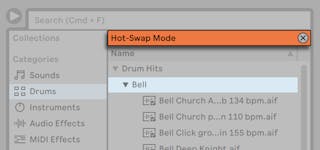
While in Hot-Bandy Style, pressing the up or down arrow key moves to the next file in the content pane, and pressing Enter or double-clicking the file loads it into the Impulse slot (presumably while Impulse is playing incoming MIDI notes). The link betwixt the browser and the musical instrument will be broken if a different view is selected, or if the Q key or the Hot-Swap button is pressed again. Hot-swapping can too exist cancelled with a press of the ESC key or by pressing the close button in the Hot-Swap bar at the top of the browser.
When Hot-Swap Fashion is re-entered, the browser volition show the location of the currently loaded audio and pre-select it.
five.2 Sample Files
A sample is a file that contains audio data. Live can play both uncompressed file formats (WAV, AIF and Audio Designer II for Mac) and compressed file formats (MP3, AAC, Ogg Vorbis, Ogg FLAC and FLAC). (Please note that non all of these file formats can be played in the Calorie-free Edition.)
A annotation on using Variable Bit Rate (VBR) files: Please install QuickTime for decoding purposes if you practice not already have it on your organization. It can be downloaded from the Apple website*http://world wide web.apple tree.com/quicktime/download.
As Live plays the samples directly from disk, you lot tin piece of work with a large number of (large) samples without running into RAM retentivity limitations. Please note, however, that you may encounter disk throughput problems if your disk is virtually full, and/or (on Windows systems) highly fragmented. Hard bulldoze rotation speed tin can also affect disk performance. Refer to the section on managing the disk load (see 33.2) for more information.
Live tin combine uncompressed mono or stereo samples of any length, sample charge per unit or bit depth without prior conversion. To play a compressed sample, Live decodes the sample and writes the effect to a temporary, uncompressed sample file. This usually happens quickly enough that you will be able to play the sample correct away, without waiting for the decoding process to finish.
Note: When adding a long sample to a projection, Alive might tell y'all that it cannot play the sample before it has been analyzed. Please see the section on assay (see 5.2.ii) for an explanation.
v.two.ane The Decoding Enshroud
To salve computational resources, Live keeps the decoded sample files of compressed samples in the enshroud. Maintenance of the cache is normally not required, as Live automatically deletes older files to make room for those that are new. Yous can, however, impose limits on the enshroud size using the File/Folder Preferences' Decoding Cache department. The cache volition not abound larger than the Maximum Cache Size setting, and it volition ever exit the Minimum Free Space on the hard disk drive. Pressing the nearby Cleanup button volition delete all files not being used by the current Live Set.
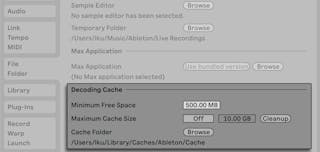
5.2.2 Analysis Files (.asd)
An analysis file is a little file that Live creates when a sample file is brought into the program for the first time. The analysis file contains data gathered by Alive to help optimize the stretching quality, speed upward the waveform display and automatically detect the tempo of long samples (encounter ix.two.3).
When adding a long sample to a project, Live might tell you that it cannot play the sample before it has been analyzed. This will non happen if the sample has already been analyzed (i.e., Alive finds an analysis file for this sample), or if the Record/Warp/Launch Preferences' Motorcar-Warp Long Samples preference (see 9.2) has been deactivated.
An analysis file can too store default prune settings for the sample:
Clicking the Clip View's Save push (come across 8.ane.8) will shop the current clip'southward settings with the sample's analysis file. The next time the sample is dragged into Live, it will appear with all its clip settings intact. This is particularly useful for retaining Warp Marking settings with the sample. Storing default clip settings with the analysis file is unlike from saving the clip as a Live Clip.
While analysis files are a handy fashion to shop default information nearly a particular sample's settings, keep in mind that you lot can apply different settings for each clip inside a Live Set — even if those clips refer to the aforementioned sample on deejay. Merely if you drag a new version of the sample into a Live Set up, Live will use the settings stored in the analysis file for the newly created clip.
The assay file's name is the same as that of the associated sample, with an added ".asd" extension. Live puts this analysis file in the same folder equally the sample.
 Samples that have an
Samples that have an .asd file are displayed like this in the browser.
 Samples without an
Samples without an .asd file await similar this.
The analysis files themselves do not appear in Live's browser.
Note that you can suppress the creation of .asd files by turning off the Create Analysis Files pick in the File/Folder Preferences. All data (except for the default prune settings) tin be recreated by Live if the .asd file is missing, however this volition take some fourth dimension for longer samples.
5.2.iii Exporting Audio and Video
The File menu's Consign Audio/Video control allows you to consign Live'southward audio output as new samples. The resulting files can exist used to burn an audio CD for listening purposes or a data CD, which could serve as a backup of your piece of work or be used with other digital audio applications. If your set includes video, you tin can too utilise the Consign Sound/Video command to export this to a new video file, which will be created in the same directory every bit the rendered sound files. (Notation: video export is not bachelor in the Lite and Intro Editions.) You lot can also upload your exported audio files directly to your SoundCloud account.
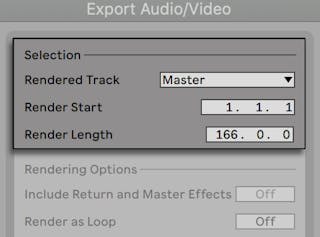
The Export dialog's Rendered Track chooser offers several options for which audio signal to render:

- Primary — the postal service-fader indicate at Live'due south Principal output. If you are monitoring the Master output, you can be certain that the rendered file will contain exactly what yous hear.
- All Private Tracks — the post-fader signal at the output of each private track, including return tracks and MIDI tracks with instruments. Alive will create a separate sample for each rail. All samples will have the aforementioned length, making information technology like shooting fish in a barrel to align them in other multitrack programs.
- Selected Tracks Only — this is identical to the All Individual Tracks choice, but only renders tracks that were selected prior to opening the Export dialog.
- (single tracks) — the post-fader signal at the output of the selected runway.
The other Selection fields determine the start time and length of the exported material:
- Return Start — sets the position at which rendering will brainstorm.
- Render Length — determines the length of the rendered sample.
Tip — a fast way to prepare both the Render Outset and Length values is to select a range of fourth dimension in the Organisation View prior to invoking the Export Audio/Video command. But remember — a rendered audio file contains only what you heard prior to rendering. So, for example, if you're playing back some combination of Session View clips and Arrangement material, so that is what will be captured in your rendered file — regardless of which view is agile when you return.
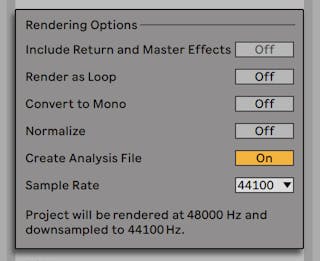
The Export dialog offers several audio rendering options:
- Include Return and Master Furnishings – If this is activated, Live will individually return each selected track with any return tracks used by that runway, every bit well as effects used in the Principal track. This is specially useful when rendering fabric for a live performance, or when providing stems to a mixing engineer or remix artist.
- Render every bit Loop — If this is activated, Alive volition create a sample that can be used as a loop. For case, suppose your Alive Prepare uses a delay effect. If Render as Loop is on, Live will go through the rendering procedure twice: The first pass will not really write samples to deejay, but add the specified filibuster consequence. As the 2nd pass starts writing audio to disk, it will include the delay "tail" resulting from the first laissez passer.
- Convert to Mono — If this is activated, Alive will create a mono file instead of a stereo file.
- Normalize — If this is activated, the sample resulting from the render process will be normalized (i.east., the file will be amplified then that the highest summit attains the maximum available headroom).
- Create Analysis File — If this is activated, Live will create an
.asdfile that contains assay information about the rendered sample. If you intend to use the new sample in Live, check this option. - Sample Rate — Note that your choice of sample charge per unit works equally follows: if y'all select a sample rate equal to or college than the rate you're using in your project (equally set in the Audio tab of Live's Preferences), Live will export in a unmarried step, at the sample rate you've chosen in the Export dialog. If y'all consign at a sample rate that is lower than your current project sample rate, Live volition first export at the current projection sample rate and then downsample the file in a second step using a loftier-quality process. Note that this may take a few moments.
- Upload Audio to SoundCloud — If activated, a helper application will launch that will allow you to upload your exported audio file to SoundCloud.
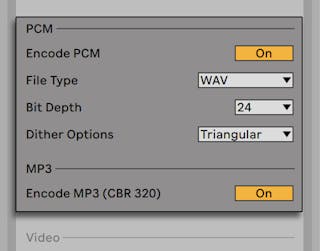
- Encode PCM — If activated, a lossless audio file is created.
- File Type — WAV, AIFF, and FLAC formats are available for PCM export.
- Bit Depth, Dither Options — If y'all are rendering at a bit depth lower than 32-flake, choose 1 of the dither modes. Dithering adds a small amount of racket to rendered audio, but minimizes artifacts when reducing the flake depth. By default, Triangular is selected, which is the "safest" mode to apply if at that place is whatsoever possibility of doing additional processing on your file. Rectangular mode introduces an fifty-fifty smaller amount of dither racket, but at the expense of additional quantization error. The three Pow-r modes offer successively higher amounts of dithering, but with the noise pushed in a higher place the aural range. Notation that dithering is a procedure that should merely be practical once to any given audio file. If you lot programme to do further processing on your rendered file, it's best to render to 32-bit to avoid the demand for dithering at this stage. In particular, the Pow-r modes should never exist used for whatsoever material that volition exist sent on to a farther mastering stage — these are for final output only. (Please note that the Pow-r modes are not available in the Intro and Lite Editions.)
- Encode MP3 — If activated, a CBR 320 kbps MP3 file is created. It is possible to export PCM and MP3 simultaneously. If neither toggle is enabled, the Export button will be disabled.
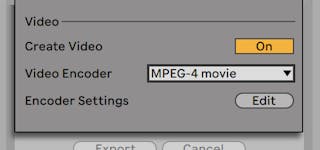
(Note: video rendering is not available in the Intro and Lite Editions.)
In addition to settings for audio rendering, the Consign dialog provides additional options for rendering video:
- Create Video — If this is activated, a video file will exist created in the same directory as your rendered audio. Note that this option is simply enabled if you have video clips in the Arrangement View. Also, it is non possible to only return a video file — enabling video rendering volition e'er produce a video in addition to rendered audio.
- Video Encoder — This chooser allows you to select the encoder to use for the video rendering. The choices yous accept here depend on the encoders you have installed.
- Video Encoder Settings — This push button opens the settings window for the selected encoder. Notation that the settings options will vary depending on the encoder you accept called. Certain encoders have no user-configurable options. In this case, the Edit button will be disabled.
In one case y'all've made your selections and clicked Export to begin the rendering process, sound rendering volition begin. After the sound rendering is complete, the video volition be rendered. Annotation that, depending on the encoder used, video rendering may occur in more than than one pass. Alive will display a progress bar that will indicate the status of the process.
Unless you've specified a special window size or attribute ratio in the encoder settings, the rendered video file will play back exactly equally it appeared during existent fourth dimension playback in Alive. The video file will as well contain the rendered audio.
For more information about working with video in Live, run into the affiliate on video (encounter Chapter 23).
Normally, rendering happens equally an offline process. But if your set contains an External Audio Outcome (see 24.18) or External Instrument (see 26.four) that routes to a hardware effects device or synthesizer, the rendering procedure is a bit different. In this instance, rendering the master output happens in existent fourth dimension. If you render unmarried tracks, all tracks that don't route to an external device anywhere in their betoken paths will be rendered offline. Then, whatever tracks that do access these devices will be rendered in real time. Live will automatically trace each runway'south signal flow and observe if real-time rendering is necessary. You lot'll then be presented with several options when you first to return:
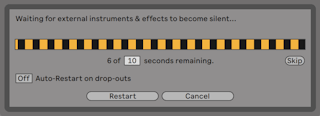
Waiting for External Devices to Become Silent.
- Skip — Past default, Alive will wait for 10 seconds before starting a existent-fourth dimension render. This should allow any sound from external devices to fade out, but if you demand more time (for example, if y'all're waiting for a long reverb tail), you can increase the wait time by typing a new number in the number box. On the other hand, if you're certain that your external devices aren't making whatsoever sound, yous tin speed the procedure forth by pressing "Skip," which will kickoff the render immediately.
After the render has begun, the dialog changes to bear witness a recording progress bar:
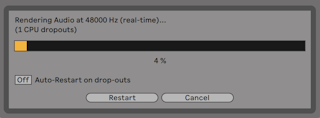
- Auto-Restart on drop-outs — Rendering in real-time requires somewhat more than CPU power than non-real-time rendering, and in some cases driblet-outs (modest gaps or glitches in the sound) can occur. Live detects when drop-outs happen, and rendering will showtime again from the get-go if the Motorcar-Restart pick is enabled.
- Restart — manually restarts the rendering procedure.
- Cancel — stops the rendering procedure and deletes the partially rendered file.
The number of rendering attempts (if there has been more than than one) will too be listed in the dialog box. If you discover that dropouts and restarts keep happening, you lot should close other running applications to allow more processing power for rendering. Delight see the affiliate on computer audio resource (see Chapter 33) for more tips on improving performance.
5.three MIDI Files
A MIDI file contains commands that prompt MIDI compatible synthesizers or instruments, such as Live's Simpler, to create specific musical output. MIDI files are exported by hardware and software MIDI sequencers. Importing MIDI files into Live works differently than with samples: MIDI file data is incorporated into the Live Fix, and the resulting MIDI clips lose all reference to the original file. MIDI files announced with a special icon in the browser.
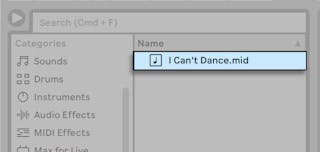
You tin import MIDI files by using the browser or the Create menu's Import MIDI File... command. Note that when using the Import MIDI File... command in the Arrangement View, the file will exist inserted at the Insert Marker position. When using the command in the Session View, the file volition be inserted in the currently selected prune slot.
v.3.ane Exporting MIDI Files
Live MIDI clips can exist exported as Standard MIDI files. To consign a MIDI clip, use the File menu's Export MIDI Prune command. This command volition open a file-relieve dialog, allowing y'all to cull the location for your new MIDI file.
Exporting a MIDI file is dissimilar from saving the prune equally a Live Clip.
5.iv Live Clips
Individual sound or MIDI clips can be exported to deejay in the Alive Clip format for like shooting fish in a barrel retrieval and reuse in any project. Audio clips just incorporate references to samples on disk (rather than the audio data itself), so they are very small-scale, which makes information technology easy to develop and maintain your own drove.
To save a clip from the open Live Prepare to disk, simply elevate it to the Places section of the browser and drib it into the Current Project or whatsoever user folder. For audio clips, Live will manage the copying of the clip's sample into this new location based on the selection in the Collect Files on Export chooser (run into 5.8.1). You can then type in a new name for the clip or ostend the one suggested by Live with Enter.
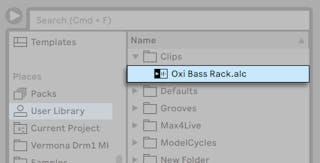
Alive Clips are a great way of storing your ideas for later use or development, as they save not just the original clip, including all its clip and envelope settings, but likewise the original track's devices. In guild to recreate a Alive Prune's device chain, either drag it into a rail containing no clips or devices, or drag it into the space in the Session or Arrangement View containing no tracks. Note that Live Clips that are imported into tracks already containing devices or clips will announced with their clip settings merely not their devices. You could, for instance, drop a bassline Alive Clip on an existing track that drives a bass instrument, rather than creating a new rails.
Clips belonging to whatever Live Sets already on deejay are also Live Clips. Please come across the section on merging Sets (see five.5.2) for more on this topic.
Note that storing default prune settings with a sample'south analysis file is different from saving a Live Clip. The default clip in the .asd file annotates the sample with sensible default values (warp, proceeds and pitch settings) so that information technology volition play in a divers mode when it is added to a set up. Live Clips, on the other hand, are stored on deejay as split musical ideas. For instance, you could create a number of variations from the same audio prune by using different warp, pitch, envelope and result settings, and store them all equally carve up Live Clips. In the browser, you lot could so independently sort and preview these clips, fifty-fifty though they are all referring to the same source sample.
v.5 Live Sets
The type of certificate that you create and work on in Live is called a Live Set. Recollect of this every bit a single "song." Sets must exist saved inside projects, so that Live can keep track of and manage all of the various components of the Alive Ready: Live Clips, device presets, any samples used, etc.
v.5.1 Creating, Opening and Saving Sets
Use the File carte's New Alive Set command to create new Alive Sets, and the Open Alive Prepare or Open Contempo Gear up control to open existing ones. In the browser, you can double-click or press Enter on a Alive Set up to open it.
The File carte du jour's Save Alive Ready command saves the current Live Fix exactly equally it is, including all clips and settings.
Yous can utilize the Save Live Gear up As command to save the current Live Fix nether a different name and/or in a dissimilar directory location, or the Save a Copy command to create a copy of the current Live Set with a new name and/or new directory location.
five.five.2 Merging Sets
Live makes information technology easy to merge sets, which tin come in handy when combining piece of work from different versions or pieces. To add together all tracks (except the return tracks) from one Live Fix into another, elevate the set from the browser into the electric current set up, and drop information technology onto any track title bar or into the drop area next to or below the tracks. The tracks from the dropped set will be completely reconstructed, including their clips in the Session and Arrangement View, their devices, and their automation.


If you prefer to import private tracks from a set, y'all can unfold the Live Set in the browser just equally if it were a binder.
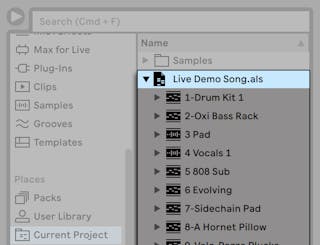
You tin at present drag the individual tracks and drib them as described at the beginning of this section. Any grooves (run across Chapter xiii) that were saved with your set are as well available as a binder inside the unfolded Set.
If you just want the device chain (eastward.g., a device and its audio or MIDI furnishings) from another set, y'all tin can drag in the Devices icon from the set in the browser.
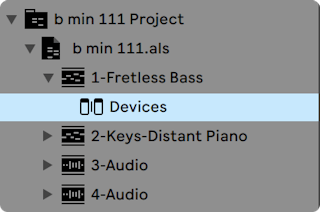
You can also drag Group Tracks (see 16.iii) and nested Grouping Tracks from Alive's browser. Grouping Tracks can be expanded in the browser, assuasive you lot to load an private track from inside.
In improver to unfolding sets, y'all can further unfold the tracks within the sets to access the individual Session View clips that were used on the track:
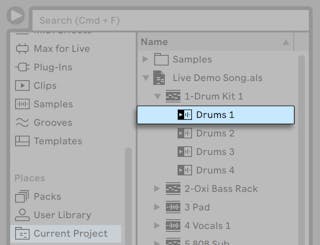
You tin can browse, preview and import Session View clips from the set equally if they had been stored as individual Live Clips. This means that any Live Ready tin serve every bit a puddle of sounds for whatever other, suggesting creative reuse and crossover.
5.5.3 Exporting Session Clips as New Sets
You tin export a selection of Session View clips equally a new Live Set past dragging them to the browser. To export a set, first click and drag, or apply the Shift or CTRL(Win) / ALT(Mac) modifiers, to select more than than one Session View clip. Then, simply drag and drop the clips into the Current Project or whatsoever user folder, where yous tin either confirm Live'due south suggested name or type in one of your ain.
5.v.4 Template Sets
Use the File carte's Salvage Alive Prepare As Default Set... command to salvage the current Live Set every bit the default template. Live will use these settings as the initialized, default land for new Alive Sets. You tin use this to pre-configure:
- Your multichannel input/output setup.
- Preset devices, like EQs and Compressors, in every runway.
- Reckoner fundamental mappings (see 29.2.v).
- MIDI mappings (see 29.1).
Note that whatsoever Live Set in Live'southward browser tin be set as the default Live Set via the Fix Default Live Set context bill of fare entry.
In addition to this "master" default template, you can create additional template sets for different types of projects, each with their own unique configuration of tracks, devices, etc. To do this, relieve the electric current Live Gear up using the File card'south Save Live Prepare As Template... command. Any sets saved as a template will appear in the browser'due south Templates category and the Templates folder in the User Library. (Annotation that the User Library's Templates binder is automatically created the first fourth dimension a template Set is saved.) These sets will then role equally templates: they will load with the configuration you saved, but with the name Untitled.als, ready to be used every bit a new fix.
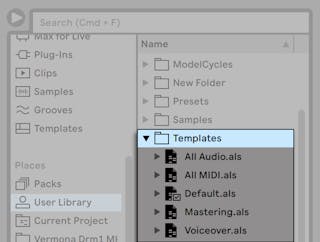
5.5.5 Viewing and Irresolute a Live Gear up's File References
To view a list of the files referenced by the electric current Alive Ready, cull the Manage Files control from the File menu, click the Manage Set button, and then click the View Files push. Live volition display one line for each file used by the Alive Set. To list all clips or instruments in the Alive Set where the file is actually used, click the triangle to aggrandize the line. Here is what you can practise:
- Supersede a file — Dragging a file from the browser and dropping it on an entry in the list makes the Alive Set reference the new file instead of the former one. For samples used in sound clips, Live retains the prune properties; the Warp Markers are kept if the new sample has the same or a greater length as the old sample and discarded otherwise. Please note that replacing a sample will alter all clips in your set that reference this sample.
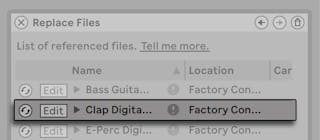
- Hot-swap files — Using the Hot-Swap button at the left-hand side of each entry, you can chop-chop scan through alternatives for the file that is currently beingness referenced. This is similar dragging files hither, only quicker.

- Edit a referenced sample — using an external application (which tin can exist chosen in the Preferences' File/Binder tab). Clicking the Edit push button will open the referenced sample in the external application. The sample will remain offline as long equally the Edit switch is engaged. For samples used in sound clips, the current ready of Warp Markers is retained but if the sample length remains the same as before. Note that the Edit button is only available for samples, not for other types of files such as Max for Live devices (see Chapter 27).

- View a file's location — The Location cavalcade states if a file is missing (run into 5.7), or if it resides in your User Library, a Projection or somewhere else ("external"). When unfolded, the entry shows the specific places in the Gear up where the file is used.
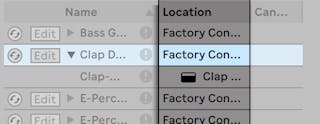
5.6 Live Projects
A Alive Project is a folder containing Live-related files that vest together. Consider, for example, work on a slice of music: You lot start out with an empty Live Set; y'all record audio and thereby create new sample files; y'all drag in samples from collections; yous save different versions of the Alive Set along the way then that you can go back and compare. Peradventure you also salve Live Clips or device presets that "belong" to this particular musical piece. The project folder for this Live Project will maintain all the files related to this piece of music — and Alive'south File Manager will provide the tools you need to manage them (see five.half-dozen.3).
v.vi.1 Projects and Live Sets
When you salvage a Live Prepare under a new name or in a new folder location, Alive will create a new project folder and store the Alive Prepare there — unless you are saving the Live Set into an existing Live Project. Allow'south look at an example to illustrate this process:
We have recorded some sound into a new Live Gear up. We now save the Alive Set under the name "Tango" on the Desktop. The Desktop is available in the browser because nosotros have previously added it as a user binder. Here is the result as displayed by the Alive browser:

The project folder ("Tango Project") contains the Alive Gear up ("Tango.als") and a Samples folder, which in turn contains a Recorded binder with two samples in it. Notation that the electric current Projection is too indicated in the title bar of Live'south application window.
Next, we record another rails into our Project. Nosotros save the modified version of the Live Set up nether a new name then that we do not lose the previous version. Accepting the Salve As control's default suggestion, we shop the new version of the song in the Tango Project folder.
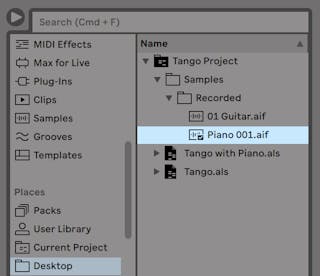
The Tango Project at present contains two Alive Sets, and its Samples/Recorded binder contains the samples used by both of them.
And now for something completely unlike: We choose the File menu'southward New Alive Prepare control and record a samba melody. As this has nil to do with our tango dabblings, we determine to save it exterior the Tango Project binder, say on the Desktop. Alive creates a new project folder named Samba Projection next to Tango Project.
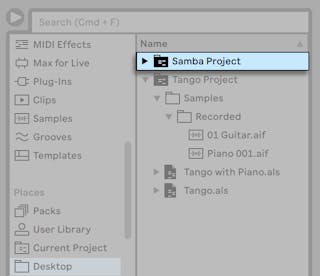
So far we have seen how to create Live Projects and save versions of Alive Sets into them. How exercise nosotros open up a Project? Only past opening any of its contained Live Sets. Double-clicking "Tango with Piano.als" opens that Ready and the associated Project — as displayed in Live's title bar.
Allow's suppose that, in the course of our work on "Tango with Piano.als," nosotros get sidetracked: The piece evolves towards something entirely different, and we experience that it should live in a Project of its own. So, nosotros "Save As..." under a new name and in some location outside the current Project, say the Desktop:
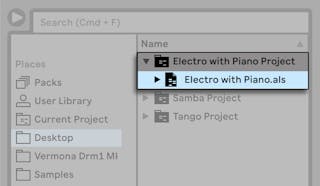
Note that the new project folder has no Samples folder (yet). "Electro with Piano.als" is still referencing the piano sample from the original Tango Project. There is aught wrong with this except for when the Tango Project is moved away or deleted; then "Electro with Pianoforte.als" will exist missing samples. You can preclude this by collecting external files (run across 5.viii). Even later on the fact, Live'south tools for searching missing files (see v.7) can help solve this problem.
In that location is actually no need to go on a Project's Alive Set exactly one level below the Projection itself. Within a projection folder, you tin can create any number of sub-folders and move files around to organize them as desired, although you many demand to utilize the File Director to "teach" the Project about the changes you've made (run across v.12.2).
In general, Live will practise what it can to preclude situations such as orphaned (Projection-less) Live Sets, which take the potential of disruptive both the user and Alive's file direction tools. Information technology cannot, yet, control situations in which Sets or files are moved out of order and become disorganized via the Explorer (Windows)/Finder (Mac).
A note for users of older Live versions: Live does not allow overwriting Alive Sets that were created past older major versions to prevent compatibility problems. Instead, you will be requested to "Save Equally...". Doing this will insure that the newly saved Alive Sets reside in project folders.
5.6.ii Projects and Presets
By default, new instrument and outcome presets are stored in your current Projection. At times even so, information technology may make more sense to save a preset to another folder or to your User Library, so that you can access them from other Projects. You can elevate a preset between folders after saving it (meet 19.i.i), or just drag the title bar of the device over a folder in the sidebar, wait for the content pane to open up, and so drop it into the content pane, adding it to the folder.
When saving presets that contain samples to a new location, Live may re-create the samples depending on the settings in the Collect Files on Consign chooser in the Library Preferences. You can and then type in a new name for the device or confirm the one suggested past Alive with Enter.
five.6.3 Managing Files in a Projection
Alive'due south File Managing director offers several convenient tools for managing Projects. Once you've opened a Live Set up that is part of the Project you wish to manage, choose the Manage Files command from the File menu, then click the Manage Project button. The File Manager will present y'all with an overview of the Project's contents and tools for:
- locating files that the Project is missing;
- collecting external files into the Project (see 5.viii) ;
- listing unused files in the Project (encounter five.x) ;
- packing a Projection in Pack format (see 5.11) ;
5.7 Locating Missing Files
If you load a Live Set, Live Clip or preset that references files which are missing from their referenced locations, Alive's Status Bar (located at the bottom of the master screen) will display a warning message. Clips and instrument sample slots that reference missing samples will appear marked "Offline," and Alive will play silence instead of the missing samples.
Live's File Manager offers tools for repairing these missing links. Click on the Condition Bar message to access these. (This is really a shortcut for choosing the Manage Files control from the File menu, clicking the Manage Set up button, and and then clicking the Locate push button found in the Missing Files department.) The File Managing director will present you lot with a list of the missing files and associated controls.

five.7.1 Manual Repair
To manually ready a cleaved file reference, locate the missing file in the browser, drag information technology over to the File Manager and drop information technology on the corresponding line in the list of missing files. Note that Live will not care if the file you offering is really the file that was missing.
5.seven.2 Automatic Repair
Live offers a convenient automatic search part for repairing file references. To ship Alive on a search, click the Automated Search section's Go button. To reveal detailed options for guiding the automatic search function, click the neighboring triangular-shaped push.
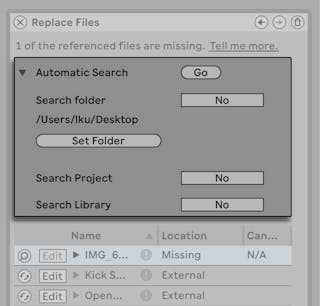
- Search Binder — includes a user-defined binder, as well equally whatever sub-folders, in the search. To select the folder, click the associated Set Folder button.
- Search Project — includes this Set's projection folder in the search.
- Search Library — includes the Live Library in the search.
For each missing file, the automatic search function may notice any number of candidates. Let's consider the following cases:
- No candidate establish — you can choose another folder and try again, or locate the sample manually.
- One candidate plant — Live accepts the candidate and considers the problem solved.
- Several candidates found — Live requires your assistance: Click the Hot-Swap button (i.eastward., the leftmost item in every line of the list of missing files) to have the browser present the candidates in Hot-Swap Fashion. You can now double-click the candidates in the browser to load them, as the music plays if yous like.
v.8 Collecting External Files
To foreclose a Alive Set from containing broken file references, Live provides the option of collecting (i.e., copying) them into the Set's project folder. This is achieved via the File Manager:
- Choose the Manage Files command from the File card
- Click the Manage Set button
- Unfold the triangular-shaped fold button in the External Files section.
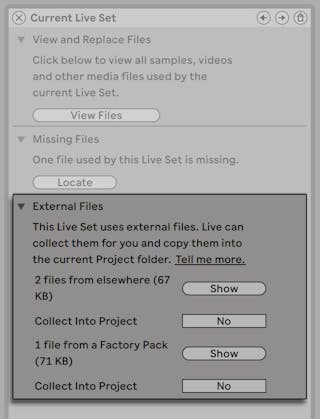
Separated by location (other Projects, the User Library, installed by manufactory Packs, and elsewhere — sample collections from external drives, for case), the File Manager provides:
- A file count and the associated disk infinite used;
- A Show button that will list the files in the browser;
- A Yes/No toggle for engaging or disengaging collection.
Notation: Brand certain to confirm your choices by clicking the File Manager'due south Collect and Save button!
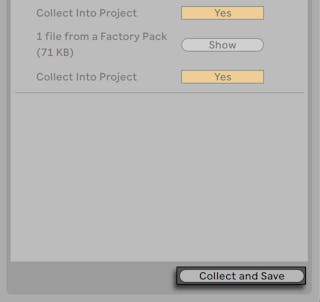
The File menu's Collect All and Save control is a shortcut that collects and saves all external files referenced past the current Gear up, including those from Live'southward Cadre Library or other installed Packs. Note that this can cause a lot of copying, especially if your Live Set uses big multisample collections!
5.8.ane Collect Files on Export
When you salve Live Clips, device presets or tracks past dragging them into the Browser, Live manages the copying of associated files based on the selection fabricated in the Collect Files on Export chooser in the Library Preferences. This chooser provides the following options:
- Always, the default setting, volition copy files into the same folder every bit the prune, preset, or rails without notification.
- When Ask is selected, Alive provides a dialog box with options for copying files.
- Never means that files will not be copied when saving.
5.9 Aggregated Locating and Collecting
Instead of having to deal with bug while you are in a creative mode, y'all might prefer putting aside some dedicated housekeeping time to solve all the bug in one become. Using Live's File Manager, you can find missing files and collect external files not only for the electric current Live Set up but also for:
- The User Library — choose the Manage Files command from the File menu; then click the Manage User Library button.
- The current Live Projection — choose the Manage Files command from the File menu; then click the Manage Project button.
- Any Live Project — right-click(Win) / CTRL-click(Mac) on a Project in the browser'due south content pane, and cull the Manage Project selection.
- Any option of Live Sets, Live Clips, Live Presets — correct-click(Win) / CTRL-click(Mac) on the respective items in the browser, and cull the Manage Files command.
Remember to click the Collect and Save button at the bottom of the File Manager when you are finished. Otherwise your changes will be discarded.
5.ten Finding Unused Files
Alive'due south File Manager can detect the unused files in a Project for you. You lot can and so review them and decide to delete them individually or collectively. When searching for "unused" files, Live will inspect each file in a Project folder, checking if information technology is referenced by whatever of the Alive Sets, Alive Clips or device presets in the Project. If not, the file is regarded as unused — fifty-fifty if other Projects or programs all the same use it.
To find the unused files for the currently open up Projection, choose the Manage Files command from the File menu, click the Manage Project button, so click on the triangular-shaped fold push button next to "Unused Files" to access a summary and the Bear witness button. Clicking the Evidence button makes the browser list the unused files; there, you can preview samples (see 5.1.four) and delete them if yous like.
Notation you tin can likewise discover the unused files from the Library: choose the Manage Files command from the File menu, and then click the Manage Library button, and so see the Unused Files section.
Concluding simply non least, you can find the unused files for all Projects found in a specific folder (and its sub-folders): right-click(Win) / CTRL-click(Mac) on a folder in the browser and choose the Manage Projects command, then meet the Unused Files section. Live inspects each Project individually and labels a file unused even if another Projects in the same folder does apply that file. To forbid losses, you may want to first collect the files into their respective Projects so purge the Projects of unused files.
five.eleven Packing Projects into Packs
Live'south File Manager provides the option of packing a Live Project in Pack format for convenient archiving and transfer. To do this, choose the Manage Files command from the File menu, click the Manage Project push button, and so click on the triangular-shaped fold button next to "Packing." Click the Create Pack push button to bring upwards a file-select dialog where you can specify the name and location of a new Pack file. Creating a new Pack from a Projection does not touch the Project. If you want the Projection deleted, yous can delete it using the browser.
Live employs lossless compression techniques to minimize the file size of Packs. Depending on the audio materials in a Project, this saves up to 50 pct in file size.
To unpack a Pack (i.e., to restore the original Live Project), double-click the Pack file (.alp), drag it into the Live principal window, or locate it via the File menu's Install Pack command.
v.12 File Management FAQs
five.12.one How Practise I Create a Project?
A Projection is automatically created whenever you salve a Live Set, except when yous save it into a preexisting Project.
five.12.2 How Tin can I Salvage Presets Into My Current Project?
You tin can relieve presets directly to the current project by dragging from the device's championship bar and dropping into the Current Projection characterization in the browser. Y'all tin and so use the File Management tools, collect any referenced samples, etc.
5.12.iii Can I Work On Multiple Versions of a Set?
If you'd like to work on different versions of the same Live Gear up, save them into the same Project. This will usually be the Project that was created when you saved the first version of the Live Ready. If a Project contains multiple Alive Sets information technology will only collect ane copy of any samples used by the various versions, which can salvage disk space and help with organisation.
v.12.four Where Should I Save My Alive Sets?
You can relieve Alive Sets anywhere yous want, but saving to pre-existing Projection folders can cause problems, and should be reserved for special cases. Y'all should only salve a Live Gear up to an existing Project if it is somehow related to the Projection — for instance, an alternating version of a song that's already in the Project.
v.12.5 Can I Use My Own Binder Construction Inside a Project Binder?
You can organize your files whatsoever way you want within a Project, merely you'll demand to use the File Manager to relink the files that you lot've moved effectually:
- In Live's Browser or via your operating arrangement, reorganize the files and folders within your Project folder.
- Navigate to the Project folder in the Browser and choose Manage Project via the right-click(Win) / CTRL-click(Mac) context carte du jour.
- If yous've changed the original location of any samples used in the Project, the Missing Samples section of the File Manager will signal this. Click the Locate button to search for the samples.
- Since you know that your samples are all in the Project folder, unfold Automatic Search. And then enable the Search Project and Fully Rescan Folders options. Finally, click Go to initiate the search.
- When searching is consummate, click Collect and Salvage at the lesser of the File Managing director to update the Project.
Source: https://www.ableton.com/en/manual/managing-files-and-sets/
Posted by: houstonvaing1995.blogspot.com

0 Response to "How To Turn Off Update Check And User Data Sending Ableton"
Post a Comment